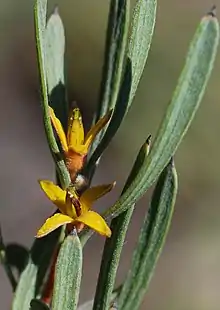| Persoonia trinervis | |
|---|---|
 | |
| Near Brookton | |
| Scientific classification | |
| Kingdom: | Plantae |
| Clade: | Tracheophytes |
| Clade: | Angiosperms |
| Clade: | Eudicots |
| Order: | Proteales |
| Family: | Proteaceae |
| Genus: | Persoonia |
| Species: | P. trinervis |
| Binomial name | |
| Persoonia trinervis | |
| Synonyms[1] | |
Persoonia trinervis is a species of flowering plant in the family Proteaceae and is endemic to the south-west of Western Australia. It is an erect, sometimes spreading shrub with densely hairy young branchlets, spatula-shaped or lance-shaped leaves with the narrower end towards the base, and densely hairy yellow flowers.
Description
Persoonia trinervis is an erect, sometimes spreading shrub that typically grows to a height of 0.3–1.8 m (1 ft 0 in – 5 ft 11 in) with young branchlets that are densely covered with greyish to rust-coloured hair. The leaves are spatula-shaped, or lance-shaped with the narrower end towards the base, 15–70 mm (0.59–2.76 in) long and 3–10 mm (0.12–0.39 in) wide with three or six prominent parallel veins and sometimes twisted through up to two complete turns. The flowers are arranged singly or in groups of up to four, each flower on a densely hairy pedicel 1–3.5 mm (0.039–0.138 in) long with a scale leaf at the base. The tepals are yellow, 8.5–16 mm (0.33–0.63 in) long and densely hairy on the outside. Flowering occurs from September to December and the fruit is a smooth, oval drupe.[2][3][4][5]
Taxonomy
Persoonia trinervis was first formally described in 1856 by Carl Meissner in de Candolle'sProdromus Systematis Naturalis Regni Vegetabilis from specimens collected by James Drummond in the Swan River Colony.[6][7]
Distribution and habitat
This geebung grows in heath and mallee woodland in the area between Mount Peron near Jurien Bay, Lake Grace, Frank Hann National Park and Watheroo in the south-west of Western Australia.[3]
Conservation status
Persoonia rufiflora is classified as "not threatened" by the Government of Western Australia Department of Parks and Wildlife.[5]
References
- 1 2 "Persoonia trinervis". Australian Plant Census. Retrieved 12 November 2020.
- ↑ "Persoonia trinervis Meisn". Flora of Australia Online. Department of the Environment and Heritage, Australian Government.
- 1 2 Weston, Peter H. "Persoonia trinervis". Australian Biological Resources Study, Department of Agriculture, Water and the Environment: Canberra. Retrieved 12 November 2020.
- ↑ Weston, Peter H. (1994). "The Western Australian species of subtribe Persooniinae (Proteaceae: Persooniodeae: Persoonieae)". Telopea. 6 (1): 120–122. Retrieved 12 November 2020.
- 1 2 "Persoonia trinervis". FloraBase. Western Australian Government Department of Biodiversity, Conservation and Attractions.
- ↑ "Persoonia trinervis". APNI. Retrieved 24 January 2018.
- ↑ de Candolle, Alphonse (ed.); Meissner, Carl (1856). Prodromus Systematis Naturalis Regni Vegetabilis (Volume 14). Paris. p. 333. Retrieved 12 November 2020.
{{cite book}}:|first1=has generic name (help)CS1 maint: location missing publisher (link)